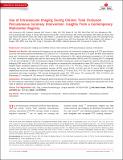Use of Intravascular Imaging During Chronic Total Occlusion Percutaneous Coronary Intervention: Insights From a Contemporary Multicenter Registry

View/
Author
Karacsonyi, Judit
Alaswad, Khaldoon
Patel, Mitul
Bahadorani, John
Karatasakis, Aris
Danek, Barbara A.
Doing, Anthony
Grantham, J. Aaron
Karmpaliotis, Dimitri
Moses, Jeffrey W.
Kirtane, Ajay
Parikh, Manish
Ali, Ziad
Lombardi, William L.
Kandzari, David E.
Lembo, Nicholas
Garcia, Santiago
Wyman, Michael R.
Alame, Aya
Nguyen‐Trong, Phuong‐Khanh J.
Resendes, Erica
Kalsaria, Pratik
Rangan, Bavana V.
Ungi, Imre
Thompson, Craig A.
Banerjee, Subhash
Brilakis, Emmanouil S.
Note: Order does not necessarily reflect citation order of authors.
Published Version
https://doi.org/10.1161/JAHA.116.003890Metadata
Show full item recordCitation
Karacsonyi, J., K. Alaswad, F. A. Jaffer, R. W. Yeh, M. Patel, J. Bahadorani, A. Karatasakis, et al. 2016. “Use of Intravascular Imaging During Chronic Total Occlusion Percutaneous Coronary Intervention: Insights From a Contemporary Multicenter Registry.” Journal of the American Heart Association: Cardiovascular and Cerebrovascular Disease 5 (8): e003890. doi:10.1161/JAHA.116.003890. http://dx.doi.org/10.1161/JAHA.116.003890.Abstract
Background: Intravascular imaging can facilitate chronic total occlusion (CTO) percutaneous coronary intervention. Methods and Results: We examined the frequency of use and outcomes of intravascular imaging among 619 CTO percutaneous coronary interventions performed between 2012 and 2015 at 7 US centers. Mean age was 65.4±10 years and 85% of the patients were men. Intravascular imaging was used in 38%: intravascular ultrasound in 36%, optical coherence tomography in 3%, and both in 1.45%. Intravascular imaging was used for stent sizing (26.3%), stent optimization (38.0%), and CTO crossing (35.7%, antegrade in 27.9%, and retrograde in 7.8%). Intravascular imaging to facilitate crossing was used more frequently in lesions with proximal cap ambiguity (49% versus 26%, P<0.0001) and with retrograde as compared with antegrade‐only cases (67% versus 31%, P<0.0001). Despite higher complexity (Japanese CTO score: 2.86±1.19 versus 2.43±1.19, P=0.001), cases in which imaging was used for crossing had similar technical and procedural success (92.8% versus 89.6%, P=0.302 and 90.1% versus 88.3%, P=0.588, respectively) and similar incidence of major cardiac adverse events (2.7% versus 3.2%, P=0.772). Use of intravascular imaging was associated with longer procedure (192 minutes [interquartile range 130, 255] versus 131 minutes [90, 192], P<0.0001) and fluoroscopy (71 minutes [44, 93] versus 39 minutes [25, 69], P<0.0001) time. Conclusions: Intravascular imaging is frequently performed during CTO percutaneous coronary intervention both for crossing and for stent selection/optimization. Despite its use in more complex lesion subsets, intravascular imaging was associated with similar rates of technical and procedural success for CTO percutaneous coronary intervention. Clinical Trial Registration URL: http://www.clinicaltrials.gov. Unique identifier: NCT02061436.Other Sources
http://www.ncbi.nlm.nih.gov/pmc/articles/PMC5015304/pdf/Terms of Use
This article is made available under the terms and conditions applicable to Other Posted Material, as set forth at http://nrs.harvard.edu/urn-3:HUL.InstRepos:dash.current.terms-of-use#LAACitable link to this page
http://nrs.harvard.edu/urn-3:HUL.InstRepos:29407757
Collections
- HMS Scholarly Articles [17920]
Contact administrator regarding this item (to report mistakes or request changes)


